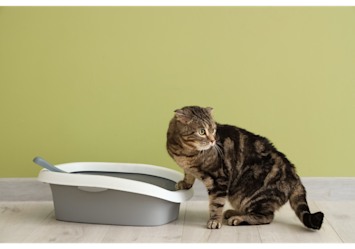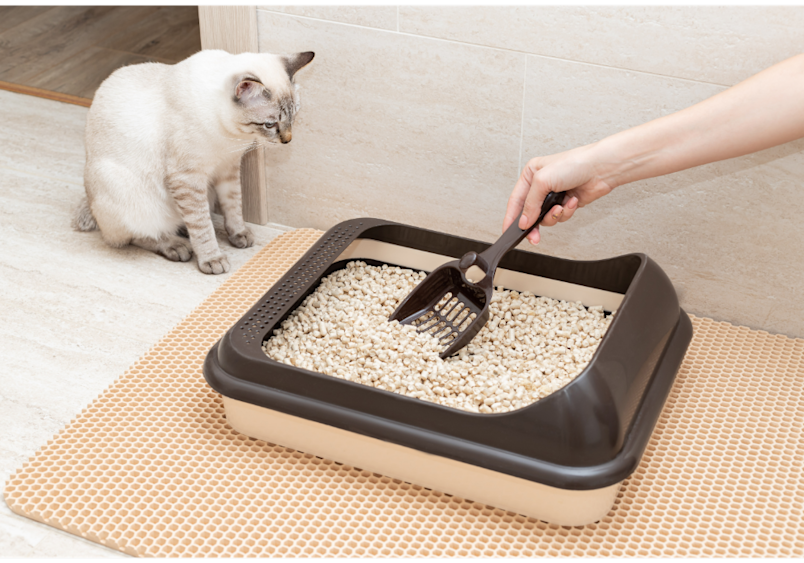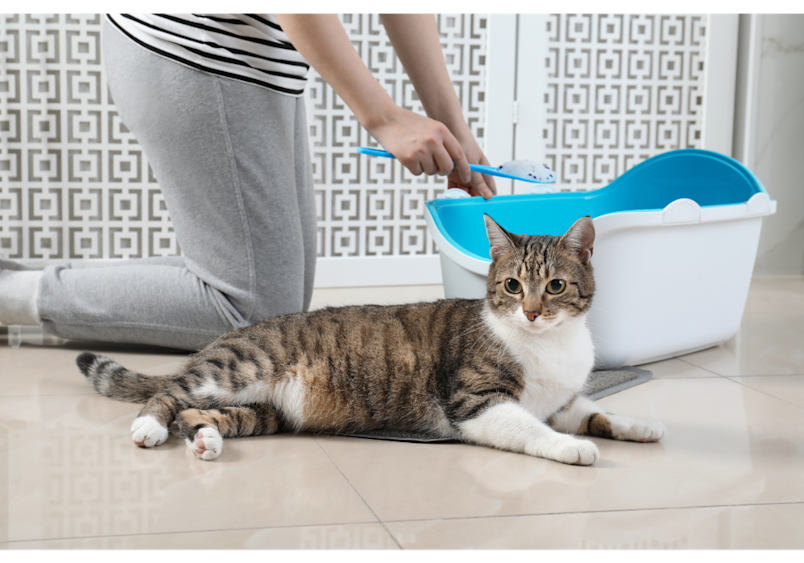
What's the real secret to a stress-free home with a cat? It's not just about training—it's about a sparkling clean litter box.
What’s the best way to control odors in your home? A clean litter box.
How do you prevent your cat from doing their business around the house? A clean litter box.
How can you keep your cat happy and healthy? A clean litter box.
Learning proper litter box maintenance is essential for every cat parent. With a consistent routine, this task becomes second nature, but neglecting it creates problems—cats hate dirty litter and will eliminate elsewhere if you don't maintain cleanliness.
Important Cat Litter Cleaning Supplies
Before diving into litter box maintenance, it's important to have the right tools on hand. Having the proper supplies makes the difference between a quick, efficient cleaning routine and a frustrating chore. Here's what you'll need:
Disposable gloves
Litter scoop with close-set holes
Unscented dish soap or bleach
Scrub brush dedicated to the litter box
Baking soda for natural odor absorption
Biodegradable waste bags and paper towels
Charcoal filter or odor-neutralizing spray for extra freshness
Safe Disinfection & Odor Control Methods for Cat Litter Box
Now that you have your supplies ready, it's time to get started on this less-than-glamorous chore. While it may not be the highlight of pet ownership, keeping your cat's bathroom properly maintained is crucial for both your kitty's health and your family's wellbeing. With the right approach, you can tackle germs and odors effectively.
Daily Care: Scoop twice daily, adding fresh litter to replace what was removed. For disposal, you have several options: a covered trash can near the litter area, a litter genie to seal odors, or flushable litter (though not all types are safe for every plumbing system). If you're going to be gone longer than a day, your cat may need additional boxes, or you might want to check out self-scooping litter boxes.
Weekly Deep Cleaning: Give your litter box a thorough weekly cleaning to maintain optimal hygiene and prevent buildup.
Empty the box completely and pre-soak with hot water and dish soap for easier cleaning.
Scrub thoroughly with a dedicated brush or sponge, paying attention to corners and crevices where bacteria hide.
Rinse completely to remove all soap residue, then air dry before refilling with fresh litter (add baking soda for extra odor control).
Complete Litter Replacement: The frequency of complete litter changes depends on the type you use and your cat's habits. Change schedules vary by litter type: clumping litter lasts up to one-month, non-clumping requires weekly replacement, and crystal litter needs changing every two to three weeks. When completely changing litter, dump contents into a sturdy plastic bag (never flush, even "flushable" types) to protect your plumbing and prevent environmental contamination that can harm marine life.
Monthly Disinfection: Beyond regular cleaning, monthly disinfection eliminates harmful bacteria and parasites that can threaten your cat's health. Use a 1:10 bleach solution and let sit for 10 minutes, then rinse thoroughly to remove all residue. White vinegar serves as a natural alternative that's safer around cats and equally effective. Never use harsh chemicals or ammonia-based cleaners, as these can be toxic to cats and may create dangerous fumes when mixed with urine.
Ongoing Odor Management: Keep your home fresh between cleanings with simple strategies
Sprinkle baking soda sparingly at the bottom before adding litter for natural odor absorption.
Place a bowl of vinegar nearby to neutralize airborne odors.
Use unscented odor-neutralizing sprays designed for pet areas. Avoid scented products that may repel your cat, as many felines are sensitive to strong fragrances and may stop using their box altogether.
Choosing the Right Litter Box and Litter for Your Cat
Unless you know your cat prefers a covered box, start with a basic rectangle tray. Covered boxes provide privacy but may feel claustrophobic to some cats, while uncovered ones allow better airflow and easier access.
What Litter Should I Get?
Choosing the right litter can be overwhelming. To find the perfect match for you and your cat, consider these questions. The answers will guide you to a litter that suits your lifestyle and your cat's preferences.
Question 1: What are your top priorities for litter maintenance?
A. I want the fastest, easiest cleanup possible. (Sounds like clumping litter might be for you.)
B. I want the best possible odor control. (You'll want to explore crystal or charcoal-infused litters.)
C. I'm focused on eco-friendly, natural options. (Pine, walnut, or paper pellets are great choices.)
D. I'm on a tight budget and want the most affordable option. (Traditional non-clumping clay litter is typically the least expensive.)
Question 2: What is your cat's history with litter?
A. My cat is a new addition to the family. (Ask the shelter or breeder what they used and start with that. Consistency is key to a smooth transition.)
B. My cat has a sensitive nose and avoids heavily scented products. (Unscented clumping or natural litters are your best bet. Scented products can deter cats from using the box.)
C. My cat is elderly or has mobility issues. (Consider a low-dust, softer texture like fine-grain clay to be gentle on their paws and respiratory system.)
Question 3: How often do you want to perform a full litter change?
A. As infrequently as possible. (Consider a clumping or crystal litter. These types can be maintained for weeks or even a month with daily scooping, which saves you time and reduces waste.)
B. Every other week. (A pellet litter is a good option. While you'll scoop solids daily, the pellets can last for several weeks before a full replacement is needed, offering a good balance of convenience and cleanliness.)
C. Weekly. (A traditional non-clumping litter is an option, but you'll need to completely empty and replace it weekly to maintain a fresh box and prevent odors.)
Always begin with a small bag and about three inches of litter in the box to see how your cat reacts. To help your cat adjust, try mixing a little of the new litter with their old litter over several days. This gradual approach can help prevent your cat from being startled by the change and avoiding the box.

Troubleshooting Litter Box Avoidance
If your cat begins avoiding the litter box, the cause is often simple to fix. First, ensure the box is clean and placed in a quiet, accessible location. However, if the issue persists after you've made these changes, the cause may be more complex. In this case, consult your veterinarian to rule out any underlying medical issues.
Common Litter Box Questions
Even with the best cleaning routine, cat parents often face unexpected challenges. If you've ever walked into a room to find your cat has "missed" the target or discovered litter tracked throughout your home, you're not alone. Here are answers to the most frequently asked litter box questions:
How Many Litter Boxes Should You Have?
The first rule of thumb is that you'll want to have at least one litter box per cat, plus a spare. So, two cats need three boxes minimum. Cats are territorial creatures, and having multiple boxes helps them feel more comfortable and secure. While it may seem like more work, having multiple boxes also prevents one box from becoming too dirty, which helps maintain cleanliness and prevents avoidance.
Where Should You Place Your Cat's Litter Box?
The boxes can be in the same area for easier cleaning. Basements, bathrooms, and laundry areas work well because they're easy-to-clean spaces. Avoid noisy appliances and ensure accessibility. Use litter mats to catch stray litter and make cleanup easier.
How do I stop litter tracking?
This occurs when tiny granules stick to your cat's paws and get scattered throughout your home as they walk away from the box. To minimize this issue, use deep-groove litter mats that effectively capture particles before they spread to your floors. Choose low-tracking litter formulas, which are specifically designed with larger or less clingy granules. Additionally, consider placing textured surfaces or multiple mats around the area to give your cat more opportunities to clean their paws.
Health and Safety Considerations for Cat Parents
If you're pregnant or have lower immunity, always wear gloves and wash your hands thoroughly after cleaning. Cat feces can contain Toxoplasma gondii, which causes birth defects. Delegate cleaning to another household member when possible.
Pet Insurance Can Help with Litter Box Issues
Litter box avoidance isn't just bad behavior; it's often your cat's way of telling you something is wrong. When a cat starts to associate their litter box with pain or discomfort, they'll often try to find a new place to go.
Before we dive into the specific issues, it’s worth noting that unexpected veterinary bills can be a huge stressor. Pet insurance can be a lifesaver, covering things like diagnostic tests, medications, and even surgery for the conditions we're about to discuss. Also consider adding an optional wellness plan to help budget for routine care like checkups and vaccinations, to make sure you catch problems as soon as possible.
Here are some common medical issues that cause litter box avoidance, along with estimated costs for diagnosis and treatment:
Urinary Tract Infections (UTIs): Cats with UTIs may strain to urinate, cry out, or make a mess outside the box. Diagnosing a UTI can involve a physical exam and a urinalysis (around $100–$200). Treatment with antibiotics typically costs between $150 and $400.
Arthritis and Joint Pain: For older cats, getting in and out of a high-sided litter box can be painful. A vet can diagnose this with an exam and possibly X-rays ($200–$500). Ongoing management with medication or supplements can range from $30–$100 per month.
Gastrointestinal Issues: Conditions like constipation or inflammatory bowel disease (IBD) can make going to the bathroom painful, causing your cat to avoid the box. Diagnosis can be complex, involving blood tests ($100–$300) and an abdominal ultrasound ($250–$500). Treatment can vary, with diagnostic costs alone often reaching over $1,000.
If you notice your cat avoiding their litter box, and you've already made sure it's clean and accessible, it's a strong sign that it's time to call your veterinarian.
Mastering Litter Box Maintenance
As we've seen, the answer to a fresh-smelling home and a happy cat is a simple one: a clean litter box. By following a consistent routine—from daily scooping to periodic deep-cleans—you can easily prevent odors, avoid accidents, and ensure your cat’s well-being. When you combine proper care with financial preparedness for unexpected health issues, you'll feel confident in your pet parenting skills. Your cat will thank you with consistent use of their clean, fresh box, and you'll get to enjoy a home that smells great.
